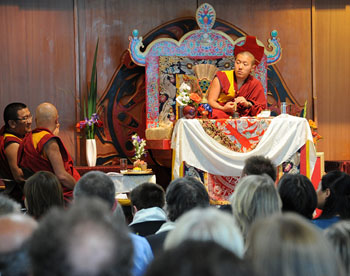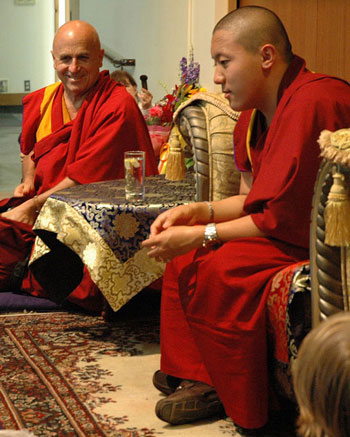
Dilgo Khyentse Yangsi Rinpoche, 17-year old reincarnation of HH Dilgo Khyentse Rinpoche, addresses an audience of over 200 people at the First Nations Long House on the Vancouver campus of the University of British Columbia. Organized by Lotus Speech Canada, the event honoring the centennial of Dilgo Khyentse Rinpoche's birth took place August 20-23, 2010.
CLICK ON IMAGE TO VIEW PHOTO GALLERY

Celebrating the Centennial of Dilgo Khyentse Rinpoche,
Welcoming Yangsi Rinpoche to the West
During a glorious sun-drenched weekend in late August, about 400 people gathered in the Long House on the campus of the University of British Columbia, Vancouver to commemorate the life and activities of one of the greatest and most beloved Tibetan spiritual masters of the 20th century. There they also met for the first time his young reincarnation who is just starting his own international dharma activities. It was a weekend, you could say, a hundred years in the making.
The occasion was the Century of Blessings Celebration, organized to mark the 100th anniversary of the birth of His Holiness Dilgo Khyentse Rinpoche (1910-1991), and at the same time to introduce to the world 17-year-old Dilgo Khyentse Yangsi Rinpoche, recognized by the Dalai Lama as Dilgo Khyentse’s reincarnation. The centennial celebrations started in Nepal in February 2010, and continued in Bhutan, France, Portugal, Croatia, New York City, Vermont, and Colorado, before landing in Vancouver.
Organized by Lotus Speech Canada, which is headed by Changling Rinpoche, himself a student of Dilgo Khyentse, and with help from the Shambhala, Siddhartha’s Intent, and Nalandabodhi sanghas in British Columbia, the Vancouver weekend kicked off with an exhibit of sacred relics and a Friday night screening of the film Brilliant Moon, recalling the life of Khyentse Rinpoche.
Audience members came from London and Los Angeles, Nepal and Seattle. Some had met and studied with Dilgo Khyentse years before, others were newer to the Dharma, yet all had some kind of connection to His Holiness—a most genuine spiritual master if there ever was one. It was highly fortunate for all gathered that some of Rinpoche’s students, Shechen Rabjam Rinpoche (Khyentse Rinpoche’s grandson and dharma heir, and primary teacher to Yangsi Rinpoche), Matthieu Ricard and Changling Rinpoche, could regale us with stories of the great master through the course of the weekend.
To hear his students tell it, Khyentse Rinpoche was simply tireless in teaching the Dharma. He often instructed his beleaguered attendants never to stop anyone who wanted to see him. “Whoever comes to see me comes in hope of seeking some comfort, so don’t stop them from seeing me,” Rinpoche said. In fact, Rinpoche once gave teachings in a hot spring to some students, and another time even from a (closed) toilet seat in the King of Bhutan’s office because someone had requested it and Rinpoche did not want to waste any time! Rabjam Rinpoche noted that he never heard his grandfather complain or say he was tired even after ten or twenty hours of teaching.
And yet, as Rabjam Rinpoche pointed out, even more than just teaching, a genuine spiritual master models a life that is one with the Dharma. Ricard and Rabjam Rinpoche both marveled that Khyentse Rinpoche was completely free from the eight worldly preoccupations said to be the cause of much suffering, carrying no hope or fear of pleasure and pain, loss and gain, praise and blame, or fame and disgrace. He didn’t worry about having more or fewer students, whether he ate good food or bad, and he treated with the same respect and equanimity all those who sought him out, from the King of Bhutan to ordinary monks and nuns, and commoners with but a few rupees to their name. "I see, I see" was his reaction to everything, good or bad. In short, Khyentse Rinpoche didn’t just teach the Dharma, he lived it.
When Dilgo Khyentse Yangsi Rinpoche, young reincarnation of the beloved teacher, entered the main hall on Saturday morning, everyone had their heads bowed, waiting, wondering how reality was going to live up to such vast expectation. The next moment, without warning, there he was, all five feet of him, if that. There was no fanfare, no preparation, just…oh, that’s him. A flash of something. Recognition perhaps.
Just by walking into that room, being himself, Yangsi Rinpoche, shy though he appeared, was announcing to us that any attempt on our part to hang on to or to replicate some nostalgic past was, like samsara itself, going to end badly.

Monk and author Matthieu Ricard (left) listens as Dilgo Khyentse Yangsi Rinpoche answers a question during the Children and Young People's Audience and Blessing.
With humility and a dry humor, Yangsi Rinpoche deftly began to disarm his audience, acknowledging that though he was recognized as Khyentse Rinpoche’s reincarnation, he didn’t have any of his predecessor’s qualities. “I’m not just saying this to impress you guys,” Rinpoche added. Whereas many people were taken by Khyentse Rinpoche’s tall and imposing form, Yangsi Rinpoche called himself “really quite short.” He went on, “And as for good looks, you can just forget about it….[The] inner quality, you can just forget about it because I don’t really have any inner quality.”
Like his predecessor, Yangsi Rinpoche was too humble to reveal any of his own inner experiences and attainments. Luckily for us though, he did impart some wisdom and showed great accomplishment that afternoon when he taught for an hour, in English (his fourth language), on the “Lineage of a Good Heart”. All 84,000 different teachings of the Buddha, Rinpoche pointed out, could be distilled to a simple instruction: to have a good heart, which means not just to be a good human being, but to wish and work to free all human beings from samsara.
With all the expectations placed on Yangsi Rinpoche to be a supreme teacher like his predecessor, it was sometimes easy to forget that the master before us was, at 17, still a young man facing some of the same challenges that any teenager living in the world today might face. That he might sometimes miss the company of those closer in age to himself became more apparent in the Children and Young People’s Blessing that Rinpoche conducted on Saturday afternoon. There, in the presence of crying babies and guileless, genuine, not-yet-self-conscious children, he seemed more relaxed and at ease than in the earlier formal talks.
On Sunday, when Yangsi Rinpoche gave the empowerment of the Rangjung Yeshe Nyingtik (“Spontaneously Arisen Heart Essence of Padma”), a terma text discovered by his predecessor, he was once again the solemn accomplished master. Later, at the end of tsok (feast) and the weekend program, when rousing anthems and songs had been sung and thanks given for all who helped make the weekend possible, when supplications had been made for Rinpoche’s longevity and quick return to Vancouver, and the audience had clapped and cheered loudly in appreciation, Yangsi Rinpoche buried his head in his left hand and looked away, almost as if embarrassed, not wanting any credit or attention.
He had told us after all that he did not want to make a big deal of his teaching in the West, that his aspiration for this visit was simply to see the West and try to understand its needs and what kind of help it might require. Raised in a traditional way, he wanted to be able to fuse for himself the traditional with the modern, so that he can be of benefit in this world at this time.
We are blessed that we were able not only to experience the presence of a genuine spiritual master, but also to be a part of his journey of becoming a master, before our eyes. Much training still lies ahead for Rinpoche, as it does for us (much more for us, alas). But we can perhaps help ourselves by looking to the inspiration and the examples of our own teachers, who every one of them faced human emotions, struggles, and not a little resistance to get to where they are.
For more information about Lotus Speech Canada, please visit: www.lotusspeech.ca.
Contributor: Sharon Owyang.
Photos: Wonderlane /Flickr.